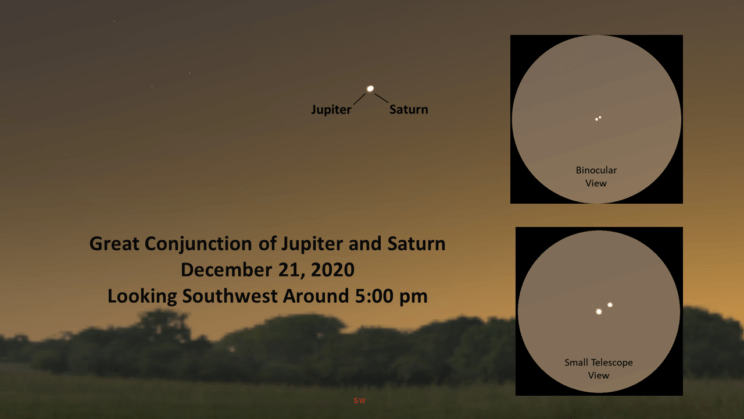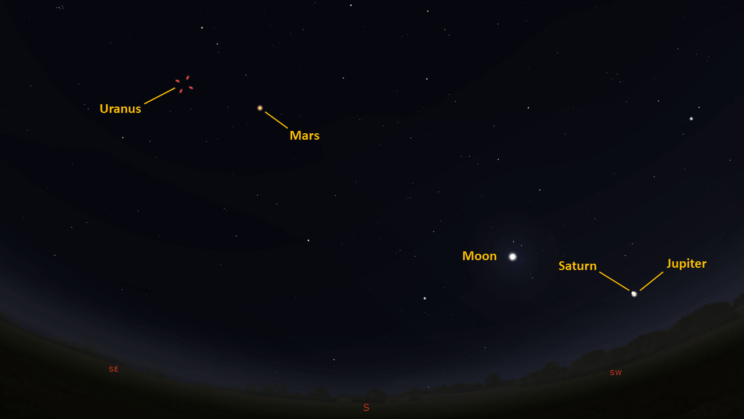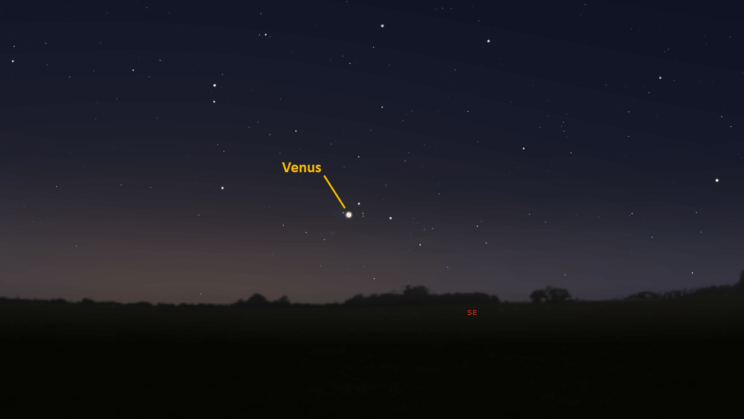This is the Saint Louis Science Center’s NIGHT SKY UPDATE for the week of Friday, December 18, 2020.
Information updated weekly or as needed.
Times given as local St. Louis time which is Central Standard Time (CST). For definitions of terminology used in the night sky update, click the highlighted text. If relying on times posted in Universal Time (UT), St. Louis is now -6 Hours from UT.
Public Telescope Viewings
Star parties at the Saint Louis Science Center have temporarily been canceled due to recommendations from the CDC regarding COVID-19. All public telescope events are canceled until further notice. As conditions change, we will reevaluate and update this article once public observing events resume.
Observing Highlight of the Week 
Jupiter and Saturn Looking Southwest at 5:00 pm on December 21, 2020
Credit: Stellarium, EG
Excitement is starting to build now that we are close to the astronomical event called the Great Conjunction. What is happening is Jupiter is appearing closer to Saturn each night as we head towards December 21. It is expected that on December 21, the two giant planets could appear close enough they may look like one bright object. This event is gaining a lot of attention because it is something that takes roughly 20 years to occur.
A conjunction in astronomy is defined as when two or more astronomical bodies share the same right ascension (RA). Right ascension and Declination are two coordinate points on what astronomers call the celestial sphere. These coordinates are similar to how longitude and latitude points help pinpoint a place on Earth. Technically the conjunction between Jupiter and Saturn occurs before they rise for us in St. Louis, but the pair of planets will appear close all day long. For us in St. Louis, Jupiter and Saturn will become visible about 10 hours after the conjunction occurred.
Another term to mention is appulse. This is used when two astronomical objects appear close to one another (closest point is the appulse). There is no real defined separation that is officially used but frequently when two objects appear within 5° of one another, it is an appulse. Jupiter and Saturn will be well within this limit on December 21. In fact, at their closest, they will be about 6 arc minutes apart. If you are not familiar with the astronomical measurements of degrees, minutes and seconds check out this article. The appulse unfortunately occurs around 12:11 p.m. Once Jupiter and Saturn become visible in St. Louis, they will only be 8 arc minutes apart. What this means for us in St. Louis is the two planets when viewed through binoculars or a telescope using low magnification, will be visible in the same view.
For naked eye views, there does not seem to be a consensus on whether the two planets will appear as one bright object, or if people will be able to see them as two distinct points. Most are saying that it will come down to a person’s vision and the condition of the atmosphere. Our atmosphere distorts light as it passes through to our eyes. A famous example of this is the twinkle of stars. The sunlight we see reflecting off planets is slightly distorted before it reaches us. It could be that this distortion could be the difference in how we perceive the two planets. We will have to wait and see how things turn out. It could be the person next to you sees two objects and maybe you will see one.
Right now, Jupiter and Saturn appear about 0.3° apart. It will be interesting to watch as the two planets get closer each night. The reason it takes the pair so long to reach conjunction is how long it takes them to complete their orbit. Jupiter takes 12 years and Saturn takes 29.5 years. After Jupiter appears to catch Saturn in the sky, it will take Jupiter about 20 years to do it again. The next Great Conjunction occurs in November 2040. It will not be as good as this year’s because Jupiter and Saturn will not appear as close together. The last Great Conjunction that was closer than this year was in 1623. That is when Galileo was alive!
To find Jupiter and Saturn from now until the Great Conjunction, just step outside and look to the southwest 15 to 30 minutes after sunset. Both planets will be easy to find as they are quite close already. If you want to confirm you are looking at planets, do the twinkle test. Generally, stars twinkle, and planets do not.
This will be an event to keep an eye on as we only see it a few times during a lifetime. These types of events are what encouraged ancient people to study the stars helping lay the groundwork for what would become astronomy today.
The Sun and Moon

The Moon as seen from the International Space Station, on July 31, 2011.
Credit: NASA
Sunrise is at 7:14 a.m. on Friday, December 18 and sunset is at 4:42 p.m. providing us with less than 10 hours of daylight. Even after sunset, the light from the Sun will dimly illuminate our sky for about 1 hour and 30 minutes. This period is called twilight, which ends around 6:18 p.m. this week. For those with a sundial, local noon occurs around 11:58 a.m. this week.
| Day | Sunrise | Sunset |
|---|---|---|
| 2020-12-18 | 7:14 a.m. | 4:42 p.m. |
| 2020-12-19 | 7:15 a.m. | 4:42 p.m. |
| 2020-12-20 | 7:15 a.m. | 4:43 p.m. |
| 2020-12-21 | 7:16 a.m. | 4:43 p.m. |
| 2020-12-22 | 7:16 a.m. | 4:44 p.m. |
| 2020-12-23 | 7:17 a.m. | 4:45 p.m. |
| 2020-12-24 | 7:17 a.m. | 4:45 p.m. |
| 2020-12-25 | 7:17 a.m. | 4:46 p.m. |
| 2020-12-26 | 7:18 a.m. | 4:46 p.m. |
Moon
Moonrise for Friday, December 18 occurs at 10:49 a.m. and moonset will occur at 9:04 p.m. On Friday, December 18 the Moon will exhibit a waxing crescent phase with 22% of the lunar disk illuminated. New moon occurs on December 14 at 10:17 p.m.
International Space Station (ISS) Observing

Visible passes of ISS from St. Louis for the week of December 18 occur during morning hours. The best passes this week occur on the mornings of December 20, 21 and 23. Use the table below for information about these and other visible passes this week.
Catch ISS from St. Louis starting Friday, December 18
| Date | Starts | Max. altitude | Ends | |||||||
|---|---|---|---|---|---|---|---|---|---|---|
| Time | Alt. | Az. | Time | Alt. | Az. | Time | Alt. | Az. | ||
| 19 Dec | -0.6 | 05:34:26 | 10 | S | 05:36:33 | 16 | SE | 05:38:41 | 10 | E |
| 20 Dec | -3.8 | 06:22:02 | 10 | SW | 06:25:24 | 89 | NW | 06:28:46 | 10 | NE |
| 21 Dec | -2.9 | 05:35:39 | 19 | SSW | 05:37:48 | 49 | SE | 05:41:04 | 10 | ENE |
| 22 Dec | -1.3 | 04:51:13 | 23 | ESE | 04:51:13 | 23 | ESE | 04:53:09 | 10 | ENE |
| 22 Dec | -2.9 | 06:24:14 | 12 | W | 06:26:58 | 32 | NNW | 06:30:02 | 10 | NE |
| 23 Dec | -3.5 | 05:39:22 | 50 | NNW | 05:39:22 | 50 | NNW | 05:42:31 | 10 | NE |
| 24 Dec | -1 | 04:54:13 | 15 | NE | 04:54:13 | 15 | NE | 04:54:54 | 10 | NE |
| 24 Dec | -1.9 | 06:27:12 | 13 | NW | 06:28:43 | 17 | NNW | 06:30:59 | 10 | NNE |
| 25 Dec | -1.9 | 05:41:50 | 19 | N | 05:41:50 | 19 | N | 05:43:35 | 10 | NNE |
Magnitude (Mag): The Measure of brightness for a celestial object. The lower the value is, the brighter the object will be.
Altitude (Alt): The angle of a celestial object measured upwards from the observer’s horizon.
Azimuth (Az): The direction of a celestial object, measured clockwise from an observer’s location with north being 0°, east being 90°, south being 180° and west being 270°.
For information about ISS flyovers and other visible satellites, visit www.heavens-above.com
Detailed information regarding all unmanned exploration of our universe, missions past, present, and planned, can be found at Jet Propulsion Laboratories:
The Visible Planets

Looking South, at 6:00 pm, December 18, 2020
Credit: Stellarium, EG

Looking Southeast, 6:00 am, December 19, 2020
Credit: Stellarium, EG
This week, four naked eye planets are visible. Jupiter and Saturn are found in the southwest once it is dark. Mars is found high in the southeast after sunset. Venus can be found in the eastern sky before sunrise.
For those tracking Jupiter and Saturn as they approach their great conjunction later this year, the two gas giants currently appear about 0.3° apart in the sky. From now until December 21, Jupiter will appear closer to Saturn each night.
Venus
Venus rises at 5:23 a.m. and will be easily seen by 6:00 a.m. Venus remains a morning object until March 26, 2021 when it reaches superior conjunction. Since Venus has passed greatest western elongation, it is exhibiting a gibbous phase.
Mars
Currently Mars appears as a -0.6-magnitude object that will be visible in the east about 30 minutes after sunset. Mars sets by 2:00 a.m. We are still near enough to Mars that surface features are visible through telescopes. Earth is moving away from Mars which means Mars is getting fainter each night. The observing season for this apparition ends around March 10, 2021 and superior conjunction occurs on October 7, 2021.
Jupiter
Look for Jupiter in the south about 30 minutes after sunset. Jupiter will set at 7:06 p.m. Those with a telescope can enjoy views of Jupiter’s cloud features and the Great Red Spot when it is pointed towards Earth.
Saturn
Look for the ringed planet in the south about 30 minutes after sunset. Saturn sets at 7:08 p.m. For those with a telescope keep track of the orientation of Saturn’s rings. Since Saturn is tilted on its rotational axis, we cross the plane of Saturn’s ring every 13 to 15 years. We are headed towards another ring plane crossing on March 23, 2025. Over the next five years you will notice Saturn’s rings will gradually incline towards an edge on appearance.
Uranus
Uranus is not a planet we normally include in this section. Even at its dimmest, the giant planet does hover within naked eye visibility. That said, it is so close to the visible limit of the human eye it just is not reality for most of us to see Uranus without binoculars or a telescope. Uranus is just past opposition and as such, it is still easy to spot. You can find Uranus in the constellation Aries the Ram. The current magnitude for Uranus is 5.7. A finder chart for Uranus can be found here.
Visit the James S. McDonnell Planetarium for more information on what’s up!
Night Sky Update: December 18-December 26, 2020






